When making ads to attract new potential clients, the copy may be the most crucial aspect, correct? However, that is simply one component of your recipe for success. Bidding on Google Ads is also an important aspect of your approach.
The truth is that competitors are continuously working just as hard as you to get the attention of your target audience, which is where Google Ads bidding comes into play. You can think of your Google Ads bidding strategy as the overarching seasoning for your marketing efforts.
Table of Contents
It not only delivers your ad to the customer, but it also helps it stand out from the crowd for a low ad fee. That is a win-win situation that cannot happen by chance. Optimize your bid strategy to maximize ad visibility and conversion rates at the best price. After all, what’s the purpose of having wonderfully crispy French fries if there’s no salt to bring them to life?
What is Google Ads bidding?
Bidding in Google Ads is the maximum amount you are ready to spend for a click on your advertisement. When your ad appears in search results or on a site within Google’s Display Network, it competes with other advertising.
A greater bid may increase your ad’s visibility. For example, if you set your bid at $1, you will pay up to $1 for each click your ad gets.
How Google Ads Bidding Works
When you visit a website within the Google search network or search results and there is ad space available, Google conducts an auction. The “winner” of this auction has their ad featured in that ad space, but just for that particular auction or instant. When another visitor visits the website or you navigate to a different search result, another auction will take place to select whose ad is highlighted.
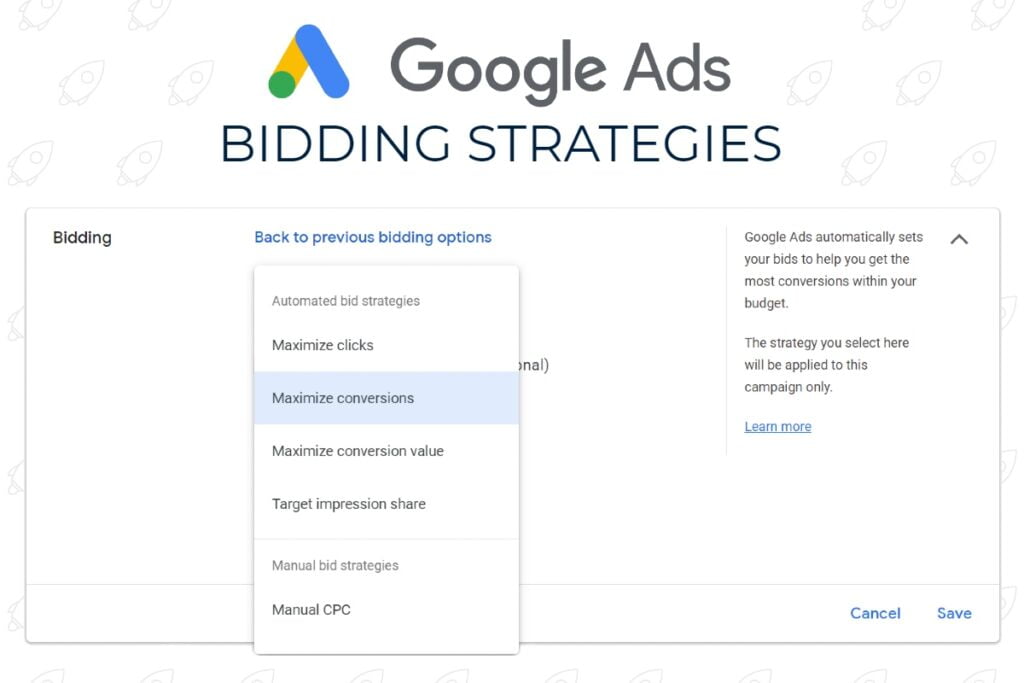
Because of this procedure, corporations can employ a variety of techniques to bid on ad space. Your ultimate goal will determine which method is best to employ. You may want to prioritize any combination of the following.
- Clicks
- Impressions
- Conversions
- Overall engagement
A good bidding approach will help you achieve your marketing objectives without wasting time or money.
When you create a new Google Ads campaign, you will be asked to choose between manual and automated bidding. For many, an automated bid approach is the best solution because it eliminates the need to constantly — and repeatedly — alter bids for multiple advertising endeavours.
However, those are not your only options. Google offers different human and automatic bid tactics to choose from.
To continue our cooking analogy, Google provides a plethora of spice options, which might be daunting if you don’t know what they are. You want to ensure that the sugar goes with the cake and the salt goes with the potatoes. In other words, your approach must be aligned with your business goals.
Types of Ad Bidding Strategies
Here, we’ll look at various sorts of Google Ads bidding methods and why you might want to employ each one.
Remember that not all strategies are appropriate for every situation. Depending on your company’s specific marketing efforts, you may opt to use one, two, or a combination of several to achieve the required outcomes.
Target Cost Per Acquisition (CPA)
If conversion monitoring is your top priority, target CPA bidding is likely the best method to adopt. This bidding technique prioritizes conversions (e.g., sales, signups, app downloads, etc.) by attempting to convert clients for a set acquisition cost.
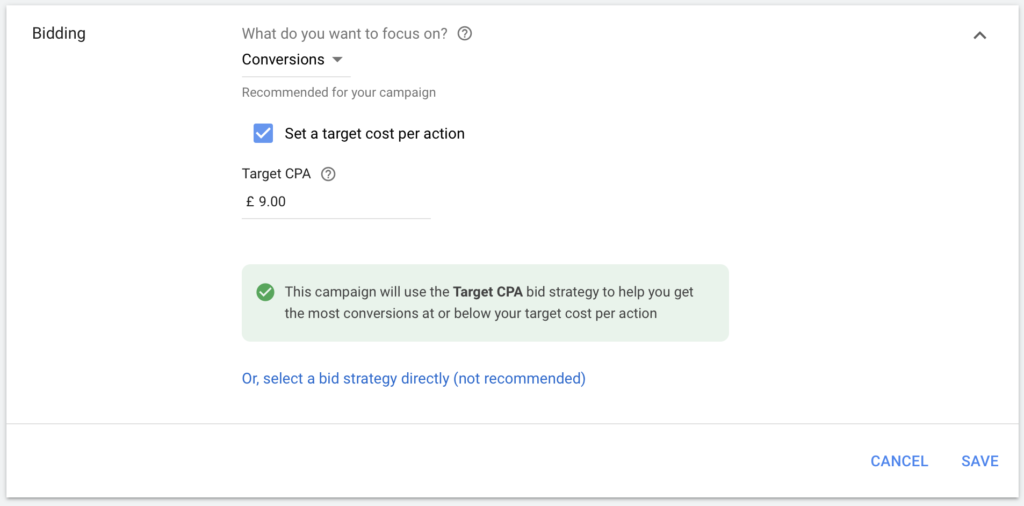
The CPA is the amount of money you’re willing to spend to attract a single customer. This strategy ensures that you keep within your budget while also meeting targets and getting leads for your ad.
When you select the target CPA strategy, Google Ads will automatically position your bids in each ad space auction based on your CPA. Depending on the auction, you may wind up with advertising that is less expensive or comparable to your acquisition prices.
Maximize Conversions
This technique is straightforward: it seeks to maximize conversions. When you create a new campaign on Google, you may specify a maximum daily budget, and Google will automatically bid to get the most conversions within that limit. This can be a simple and effective method if you intend to spend your entire money in one day (rather than over a longer period).
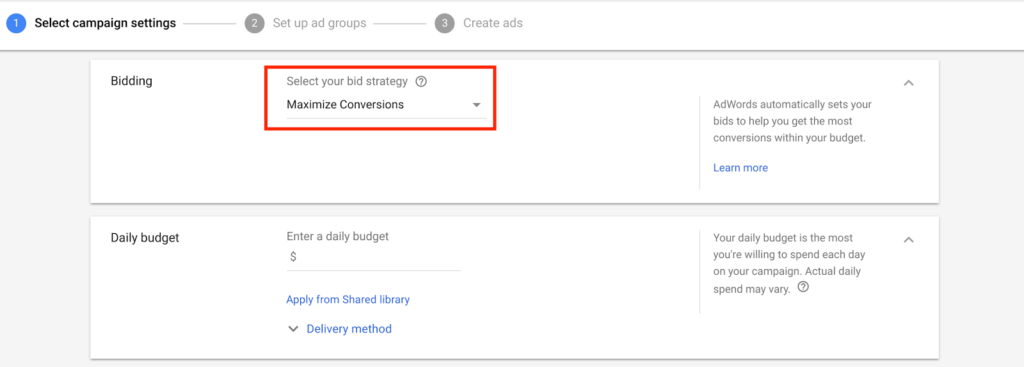
Using the maximum daily budget you provide, Google includes automated bid strategies to acquire the most conversions for your money. Also, don’t worry about spending your entire amount on one auction. Google optimizes how it spends your money so that it discovers the most people who are also the most inclined to buy. If a single conversion equals your entire budget, Google will not bid on it.
Target Return on Ad Spend (ROAS)
Does your marketing campaign have a particular return on investment (ROI) for pay-per-click (PPC) spending? If you answered yes, the target ROAS approach could be your chosen option.
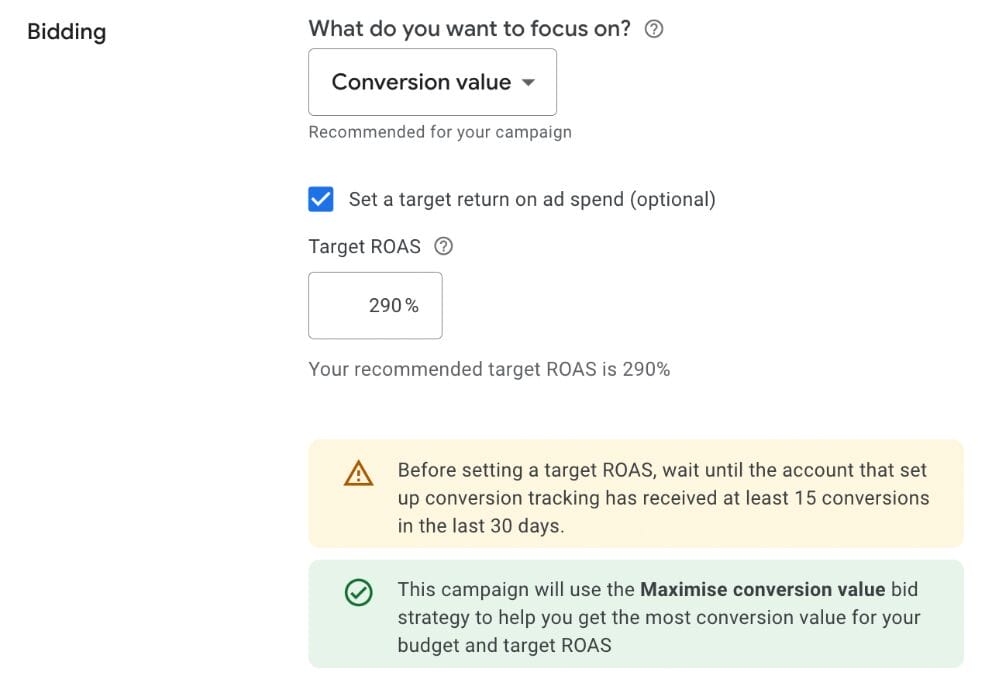
This may appear to be a complex technique because it requires more arithmetic than most marketers perform in a regular workday, but it’s rather simple once you get to the heart of it.
ROAS is a measure that incorporates your conversion values or Google Analytics eCommerce revenue numbers when placing an ad bid. When you build your campaign, you may choose your bid strategy’s target ROAS as a percentage to optimize conversion value depending on your desired return.
Maximize Clicks
If your marketing activities are currently producing high conversion rates, it may be time to prioritize visitor creation. In that situation, consider the maximize clicks technique.
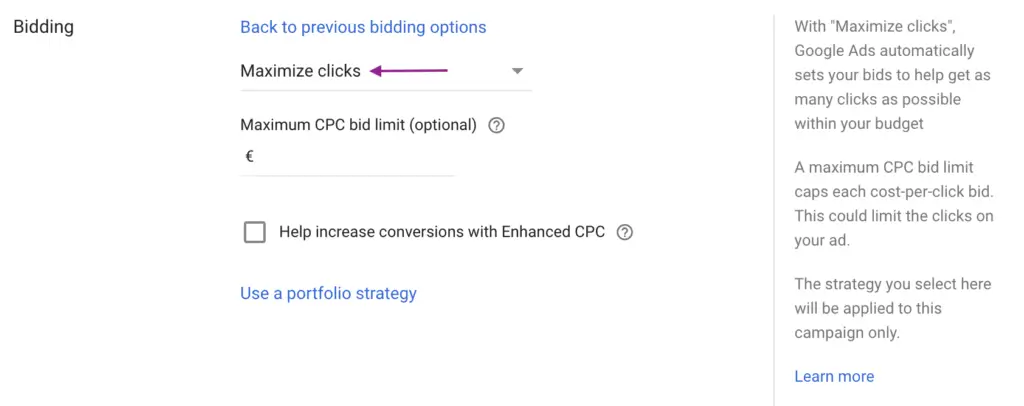
In this circumstance, you can base your automatic bidding technique on your maximum daily budget. Google Ads will automatically bid for as many clicks as possible while staying within your budget. This means you may be able to cut your cost per click (CPC) while increasing your search impression share.
Manual CPC bidding is also available to increase clicks. This is especially useful for individuals who have a limited budget and/or low search volume for the keywords in their campaigns.
Enhanced Cost Per Click (ECPC)
ECPC is a hybrid technique that combines automated and manual bidding. When utilizing manual CPC, you can allow Google Ads to increase or reduce your bids based on the likelihood of a conversion. If there is a lower possibility of conversion in this ad space, Google will lower your bid because it is less important to your campaign.
The advantage of this method is that you may select your baseline CPC based on your ad groups and keywords, and Google will alter them algorithmically for best results (thanks, machine learning!). These criteria may be based on:
- Time of day
- Intent
- Browsing behaviour
- Geographic location
- The device being used
With this option, Google assists you with bid adjustment so that your ad campaigns meet your objectives while still averaging at your maximum cost-per-click level.
Manual Cost Per Click (MCPC)
If you want much more control over your Google Ads bid strategy than ECPC, you can use a manual cost-per-click plan.
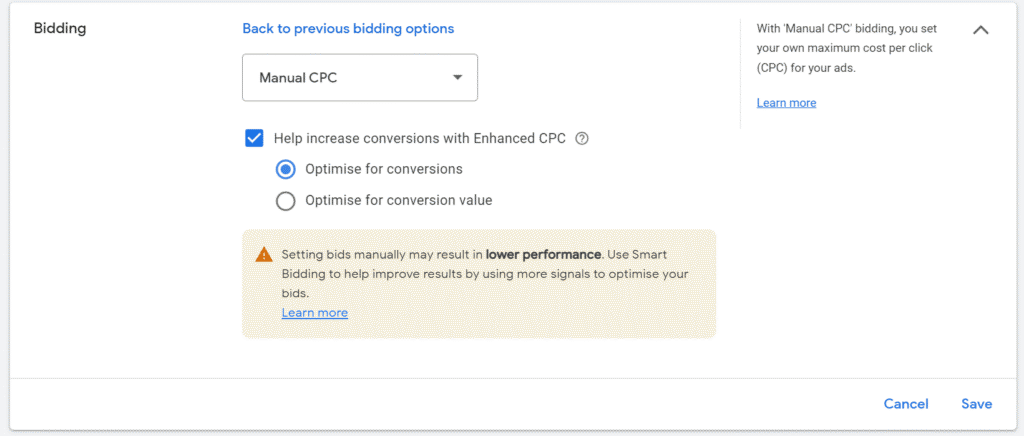
Bids in Google Ads can be set according to your study and understanding of each ad group or keyword. If certain search keywords provide more results than others, you can adjust their budgets quickly.
If you have a new account or campaign, it may be worth testing this option to discover what works best for your organization while keeping each ad inside your budget.
Maximize Conversion Value
The maximum conversion value method is similar to target ROAS (except that you do not need to define a target ROI): Google Ads uses its algorithm to maximize the return on your ad spend as much as possible.
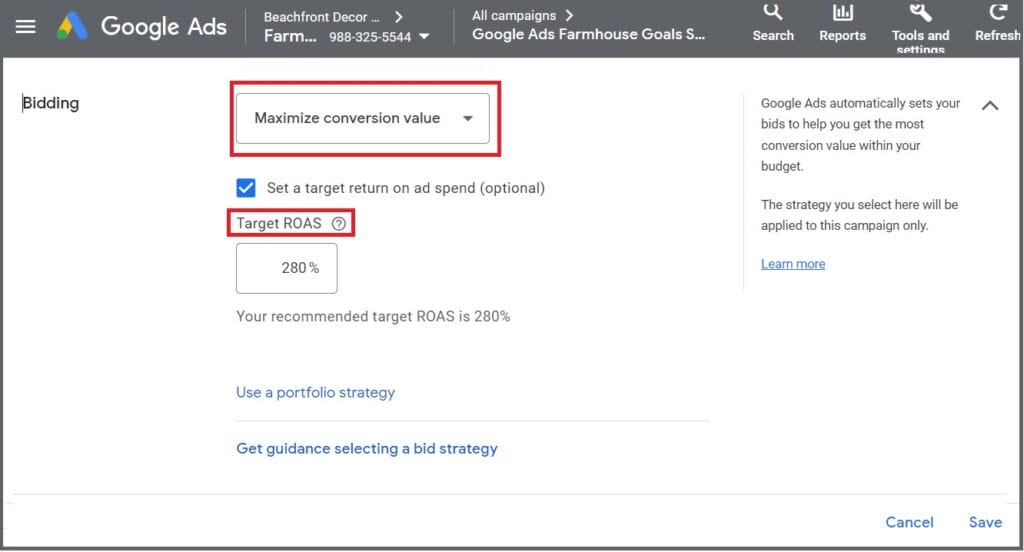
Using the information Google has about each user, it automatically adjusts your bids to obtain the optimal CPC for each auction. One advantage of this method is that it ensures you receive the most dollar-value revenue from your ads, even if you wind up spending more.
Target Impression Share
Target impression share is an automated bidding method designed to achieve your campaign’s impression share targets. It’s also a wonderful alternative if you want to ensure that your ad appears for brand keywords.
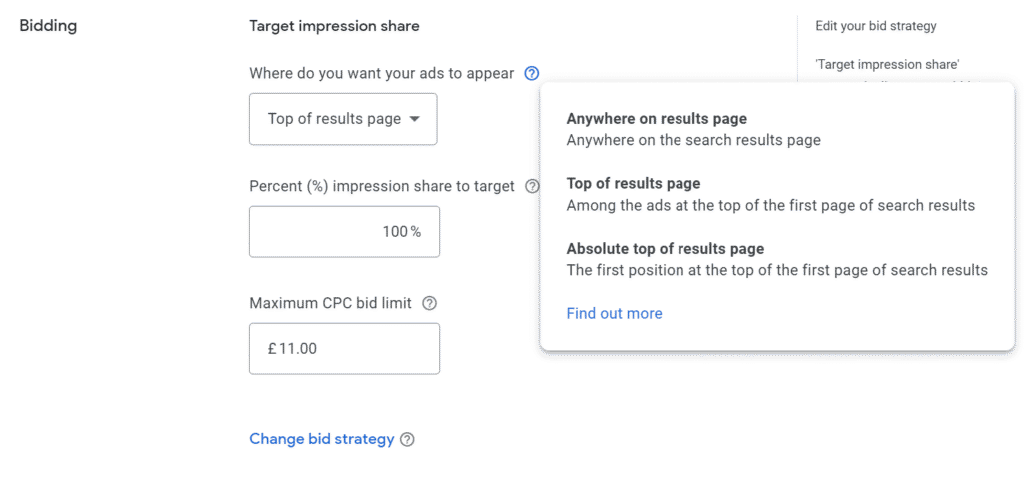
You have three possibilities for where your advertising will display on the target search page position for viewers:
- The uppermost portion of the page.
- The top (or near-top) of the page.
- Anywhere.
Remember to select a maximum CPC bid limit for this technique that corresponds to your ultimate goals; otherwise, you risk burning through your budget too rapidly.
Cost Per Thousand Impressions (CPM)
This method only works with Display Network and YouTube campaigns and bids solely on impressions. Your company is charged based on your goal CPM, which is the average bid (rather than the maximum bid) you want to spend for each 1,000 times your ad is displayed.
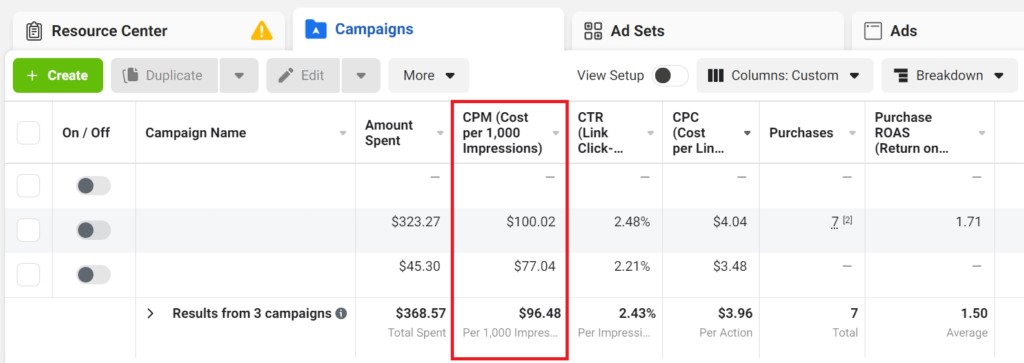
The primary advantage of adopting a CPM bidding approach is that it targets brand awareness and can generate the greatest number of unique viewers feasible. Individual viewers can skip or block YouTube’s ads, potentially reducing their efficacy.
Cost Per Thousand Viewable Impressions
This bid technique is only applicable to display networks and YouTube ads. It also does an excellent job of increasing brand awareness, so if that is your objective, this is a good bid choice.
The vCPM strategy is a manual bid option that allows you to define a maximum cost per visible 1,000 impressions. Google ads include viewable impressions. It refers to watching a two-second video ad on any platform. It also ensures that the viewer sees the complete ad to gain an impression.
The most effective way is to increase conversions. But also to ensure that constant pricing increases brand awareness among the targeted demographic.
Portfolio Bid Strategies
A portfolio bid strategy is when you establish a single bid strategy in Google Ads that can be applied to several campaigns rather than one at a time.
When you open portfolio bid strategies in your Google Ads shared library, you will see five options:
- Target CPA
- Maximize conversions
- Maximize conversion value
- Target ROAS
- Target impression share
How Google Ads Bidding Works
Google Ads auctions available ad space on SERPs and the GDN, allowing advertisers to bid on it. The greater your price, the better your chances of winning and having your ad appear in the allocated area. However, it is not only about the highest bidder. Google Ads examines various aspects when deciding who wins each auction, including:
- The maximum cost per click (CPC) is the amount you are ready to spend for a click on your ad.
Quality Score: This number assesses the quality and relevance of your ad based on projected CTR, ad relevancy, and landing page experience. - AdRank thresholds: Google Ads establishes minimal quality standards for ads to ensure that users see high-quality advertisements. Your ad must meet these requirements to display.
- Auction Competitiveness: The closer the ad rankings of two competing ads, the more fairly they compete for the same position. For example, a wider disparity in Ad Rank enhances the possibility of the higher-ranked ad winning, but at a potentially higher CPC due to the certainty of its placement.
Google advertising delivers the most relevant advertising based on the searcher’s context, which includes search keywords, location, device kind, and time of search.
Ad assets and formats have the following impact: Including ad assets such as phone numbers or other websites can improve your ad’s performance. Google Ads forecasts how these assets and formats will impact the performance of your ad, to increase exposure and interaction.
Your Ad Rank is determined by the parameters listed above, which include the competitiveness of your industry. A higher Ad Rank can result in a more prominent placement on Google’s SERPs or GDN, even if your bid is smaller than others.
To succeed with Google advertising, creating high-quality advertising and executing an effective bidding strategy is crucial. Winning high-quality ad positions can increase your advertisements’ clicks and conversions, boosting the return on your Google advertisement investment.
Here’s a summary of how Google Ads bidding works:
- Select a Google Ads bidding strategy: Choose how you want to bid. Google provides numerous strategies. For example, you can bid to increase website traffic, brand visibility, or conversions such as sales or signups.
Set a bid: Let’s imagine you decide to bid on clicks. You’re telling Google, “I’m willing to pay up to 50 cents for each person who clicks on my ad.” That is your bid. - Enter the auction: The auction begins whenever someone searches on Google. Google determines whether your ad fits what the person is looking for. If it does, you enter the auction alongside other marketers bidding on the same keyword(s). Win the auction. Google checks the bid amount and relevancy. The ad should be searchable. It must be like a farmer’s market that sells the best fruits. If the ad is exactly what the buyer is searching for and the pricing bid is reasonable. Then more likely, sales can get closed. The relevance of your ad and the amount you bid determine the visibility of your ad in Google Ads.
- Pay for the ad: You only pay the amount required to outbid the following advertisement. If you bid 50 cents and the next highest bet is 30 cents, you may only pay 31 cents for the click.
How to Choose a Bidding Strategy Aligned with Campaign Goals
Match your Google Ads bidding strategy to your specific advertising objectives. Whether your goal is to increase clicks, impressions, views, or conversions, the appropriate strategy can have a big impact on the success of your campaign.
For example, a campaign aimed at immediate sales may profit from conversion-focused bidding. Impression-based bidding may be preferred by those seeking to increase brand recognition. Consider these five basic types of goals to choose the bidding strategy that fits best:
- For direct actions and conversions: Smart Bidding optimizes bids for each auction depending on the chance of conversion, which is useful if you want to promote direct actions on your site, such as sales or signups.
- Generating website traffic: CPC bidding allows you to pay just for clicks on your advertisements, making it a low-cost option to enhance site traffic.
- Boosting brand awareness: Cost per thousand views impressions bidding is useful. It helps a message to reach several people. Through payment every thousand times ad is showcased.
- Increasing video ad views and interactions: Cost-per-view (CPV) or cost-per-thousand-impression (CPM) bidding is appropriate for video campaigns if you want to increase views or interactions with your adverts.
- Product or brand consideration through video ads: CPV is great for initiatives that create interest in your product or brand using video content.
Conclusion
Understanding and applying bid strategies can help you align your campaigns with your specific goals, manage budgets more efficiently, and significantly boost your ad performance.
As you implement a Google Ads bid strategy, monitor results continuously to learn from feedback about how it impacts your campaign goals and adapt accordingly. This approach enables you to improve campaign performance and ROI.
Drishti is an expert SEO content writer at SwiftPropel, dedicated to creating high-quality, engaging content that enhances online visibility. With a strong grasp of SEO strategies and a talent for storytelling, she produces articles that captivate readers and perform exceptionally well in search rankings. When she’s not writing, Drishti enjoys staying updated with the latest trends in digital marketing and refining her skills to maintain a competitive edge in the industry.